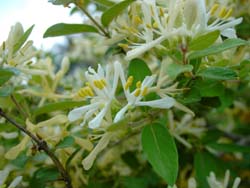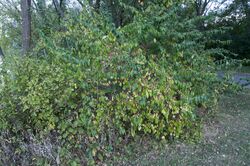Biology:Lonicera morrowii
| Morrow's honeysuckle | |
|---|---|

| |
| Scientific classification | |
| Kingdom: | Plantae |
| Clade: | Tracheophytes |
| Clade: | Angiosperms |
| Clade: | Eudicots |
| Clade: | Asterids |
| Order: | Dipsacales |
| Family: | Caprifoliaceae |
| Genus: | Lonicera |
| Species: | L. morrowii
|
| Binomial name | |
| Lonicera morrowii A. Gray
| |
Lonicera morrowii, the Morrow's honeysuckle,[1][2] is a deciduous honeysuckle in the family Caprifoliaceae, native to Japan , Korea, and Northeast China. It is a shrub, reaching a height of 2–2.5 m, with oblong leaves 4–6 cm long. It leafs out quite early in the spring, and in North America is commonly the first deciduous shrub with foliage in March. The flowers are white to pale yellow, and the fruit is a dark red berry 7–8 mm diameter containing numerous seeds. The berries, while eaten frequently by birds, are considered poisonous to humans. It is colloquially called "bush honeysuckle" in the United States, and is considered an invasive species.
In cultivation, Lonicera morrowii has hybridized with other shrubby species of Lonicera. Crossed with L. tatarica, it forms the invasive hybrid L. × bella.[3] It can also hybridize with L. ruprechtiana.[4]
As an invasive species
Morrow's honeysuckle is confirmed as a highly invasive species over the northeastern third of the United States.[5][6] Morrow's honeysuckle thrives at the edges of forests, roads, or other natural or man-made barriers, but is not limited to them, and is found in both mature and disturbed forests.[7] In some areas, Morrow's honeysuckle is the dominant plant species, especially in areas of disturbed ecological succession. It is suspected that Lonicera morrowii is allelopathic, and may capitalize on disturbed ecological succession by establishing itself and then preventing the growth of plants underneath it.[7] With a sufficiently established thicket of honeysuckle, even other shade-tolerant, invasive species, such as fortune's spindle have difficulty growing underneath it, whether due to its suspected allelopathic activity or through soil depletion.[8]
Effects on flora and fauna
Due to its early leafing, Morrow's honeysuckle is particularly harmful to spring ephemerals, flowers that evolved to bloom briefly in the spring before other plants leafed out.[8]
Many cedar waxwings' wax spots in the eastern United States have taken on an unusual orange hue in the last 35 years, a phenomenon that has been attributed to Lonicera morrowii.[9] The chemical involved in this color change is rhodoxanthin, a red dye found in the berries of Morrow's honeysuckle.
References
- ↑ (xls) BSBI List 2007, Botanical Society of Britain and Ireland, https://bsbi.org/download/3542/, retrieved 2014-10-17
- ↑ "Lonicera morrowii". Natural Resources Conservation Service PLANTS Database. USDA. https://plants.usda.gov/core/profile?symbol=LOMO2. Retrieved 26 January 2016.
- ↑ Barnes, William J.; Cottam, Grant (1974). "Some Autecological Studies of the Lonicera × bella Complex". Ecology 55 (1): 40–50. doi:10.2307/1934616.
- ↑ Green, P.S. (1966). "Identification of the Species and Hybrids in the Lonicera tatarica Complex". Journal of the Arnold Arboretum 47 (1): 75–88. doi:10.5962/p.324689.
- ↑ Distribution map of Lonicera morrowii nps.gov
- ↑ "Lonicera morrowii", Go Botany (New England Wildflower Society), https://gobotany.nativeplanttrust.org/species/Lonicera/morrowii/
- ↑ 7.0 7.1 "SEEPPC/Bush Honeysuckles". 20 January 2011. https://wiki.bugwood.org/Archive:SEEPPC/Bush_Honeysuckles_-_Lonicera_spp..
- ↑ 8.0 8.1 "Morrow's honeysuckle | (Lonicera morrowii) | Wisconsin DNR". http://dnr.wi.gov/topic/invasives/fact/morrowshoneysuckle.html.
- ↑ Invasives Plant Pests Literature Collection: Lonicera morrowii utk.edu [yes|permanent dead link|dead link}}]
External links
Wikidata ☰ Q2701825 entry
 |


